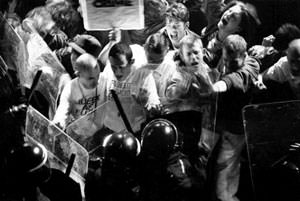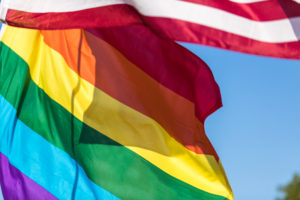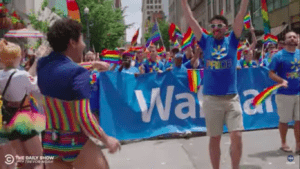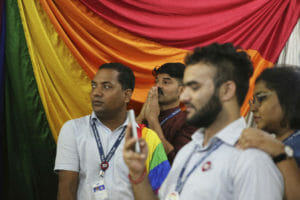Homo Nest Raided, Queen Bees Stinging Mad
Among the many landmarks of the turbulent decade of the 1960s, few have achieved the fame and symbolic resonance of events that began as a fairly routine example of police harassment on a hot June night in 1969.
This article is a companion to another report on New York’s historic legalization of gay marriage.
Among the many landmarks of the turbulent decade of the 1960s, few have achieved the fame and symbolic resonance of events that began as a fairly routine example of police harassment on a hot June night in 1969. Police raids on gay bars were neither new nor unusual, though they had become less frequent by the late 1960s. When the police raided the Stonewall bar in Greenwich Village on June 28 they did not expect to set off a riot — and they certainly did not expect to ignite the explosion of a militant gay rights movement. But when many bar patrons, soon joined by allies on the streets, fought back, the incident sparked several nights of rioting — and the Stonewall riots set off a flurry of organizing that soon turned into a firestorm of activism across the country.
Stonewall wasn’t the first bar whose patrons fought the police — that honor probably goes to The Patch in Los Angeles. Many theories have been put forward to explain why the Stonewall raid erupted in violence — among them that Judy Garland’s funeral took place earlier that day. It might also be asked why this particular riot sparked a firestorm. The symbolic importance that Stonewall assumed may have resulted in part from the fortuitous name of the bar that the police chose to invade that June night. Had the riots taken place at the Sewer or The Snake Pit, to name two other contemporary Village bars, there would hardly have been the militant resonance of Stonewall.
|
Related interview from Truthdig Radio: |
On the night of the Stonewall riots the media were unaware of the historic significance of the events in the Village. Even though the editor on night duty at The New York Times realized that “these guys are fighting the cops for the first time” and dispatched a reporter to the scene, he also knew that the topic of homosexuality was not popular with the top brass. The Times’ brief account of the event was buried on Page 33 and told from the police’s perspective. As the riots continued, the Times ran a second story the next day, also on Page 33, one that again focused on the official point of view: “Police Again Rout ‘Village’ Youths.”
Other New York media were less subtle than the Times, even if no more sympathetic to the Stonewall rioters. The New York Daily News waited until July 6 to cover the story, but its reporter was at least aware that something significant had occurred. This did not prevent him from treating the riots as an occasion for heavy-handed humor. The story was headlined “Homo Nest Raided, Queen Bees Are Stinging Mad,” and it continued in that vein:
She sat there with her legs crossed, the lashes of her mascara-coated eyes beating like the wings of a humming-bird. She was angry. She was so upset she hadn’t bothered to shave. A day-old stubble was beginning to push through the pancake makeup. She was a he. A queen of Christopher Street. Last weekend the queens had turned commandos and stood bra strap to bra strap against the invasion of helmeted Tactical Patrol Force. The elite police squad had shut down one of their private gay clubs. … Queen power reared its bleached blonde head in revolt. New York City experienced its first homosexual riot.
The Village Voice, Greenwich Village’s local, countercultural paper, was no more delicate in the choice of language to describe the momentous events happening in its own backyard. Voice reporter Lucian Truscott IV, who came upon the riot as he walked through the Village that night, wrote an account that referred to “the sudden specter of ‘gay Power’ [that] erected its brazen head and spat out a fairy tale the like of which the area has never seen” when “the forces of faggotry” rallied in protest against the raid. Truscott did capture some of the significance of the riots, however, in the words of gay poet Allen Ginsberg, whom he quoted near the end of his article: “You know, the guys out there were so beautiful — they’ve lost that wounded look that fags all had 10 years ago.”
The Village Voice was soon to learn that the “forces of faggotry” were willing to fight the media as well as the police. In the wake of the Stonewall riots a group of gay activists quickly organized a rally that led to the formation of the Gay Liberation Front (GLF) and the birth of a new, radical, gay liberation movement modeled on such ’60s groups as Students for a Democratic Society (SDS) and the Black Panther Party. Writing in their column in the underground newspaper SCREW, Jack Nichols and Lige Clarke said, “The revolution in Sheridan Square must step beyond its present boundaries. The homosexual revolution is only a part of a larger revolution sweeping through all segments of society.”
The name Gay Liberation Front was an obvious reference to the Vietnamese National Liberation Front, reflecting the activists’ engagement in the anti-war movement. Karla Jay and Allen Young’s 1972 collection “Out of the Closets: The Voices of Gay Liberation” included a listing of lesbian and gay organizations in 36 states, the District of Columbia and 10 other countries. California alone was represented by 74 organizations, 16 of them called Gay Liberation Front.The GLF quickly grew and began to organize on several fronts. One of its first projects was to organize dances for young people as an alternative to the Mafia-controlled bars. But when they tried to advertise their dances in the Village Voice they were told that the word gay was obscene and could not be used in the ad. To make matters worse, the Voice, willing to use words like “faggots,” “dykes” and “queers” in its news articles on the Stonewall riots, also ran ads for apartments that specified “no gays.”
GLF members showed up outside the Voice, not far from the Stonewall bar, on Sept. 12, 1969, carrying picket signs denouncing the newspaper’s policies. After several hours some of the demonstrators were invited to meet with the publisher. The meeting was heated but the GLF was victorious. The Voice agreed to allow gay and homosexual to appear in ads without alterations. While not a total victory — the publisher reserved the right of his reporters to use derogatory language — this was a milestone of lesbian and gay media activism: It was a sign of the new militancy of a gay movement that was taking its demands directly to the media, making them targets of protest, along with politicians, psychiatrists and preachers.
On the first anniversary of Stonewall, the first gay pride march was held in New York City — such marches are now annual events in cities across the country and in many countries around the world — and The New York Times took notice. The “quote of the day” was a statement by one of the organizers that summarized the core belief of gay liberation: “We’re probably the most harassed, persecuted minority group in history, but we’ll never have the freedom and civil rights we deserve as human beings unless we stop hiding in closets and in the shelter of anonymity.”
Larry Gross is the director of USC’s Annenberg School for Communication, one of the founders of queer studies and a scholar of art, media, and the portrayal of minorities.
Your support matters…Independent journalism is under threat and overshadowed by heavily funded mainstream media.
You can help level the playing field. Become a member.
Your tax-deductible contribution keeps us digging beneath the headlines to give you thought-provoking, investigative reporting and analysis that unearths what's really happening- without compromise.
Give today to support our courageous, independent journalists.



You need to be a supporter to comment.
There are currently no responses to this article.
Be the first to respond.